Infections: Clostridium difficile - Morphology, Epidemiology, Pathophysiology, Diagnosis, Treatment, Prevention
VerifiedAdded on 2023/04/21
|10
|2069
|54
AI Summary
This scientific report discusses the morphology, epidemiology, pathophysiology, diagnosis, treatment, and prevention of Clostridium difficile infections. It covers topics such as the rod-shaped gram-positive bacterium, transmission in hospital settings, laboratory diagnosis, antibiotic and surgical treatment options, and preventive measures.
Contribute Materials
Your contribution can guide someone’s learning journey. Share your
documents today.
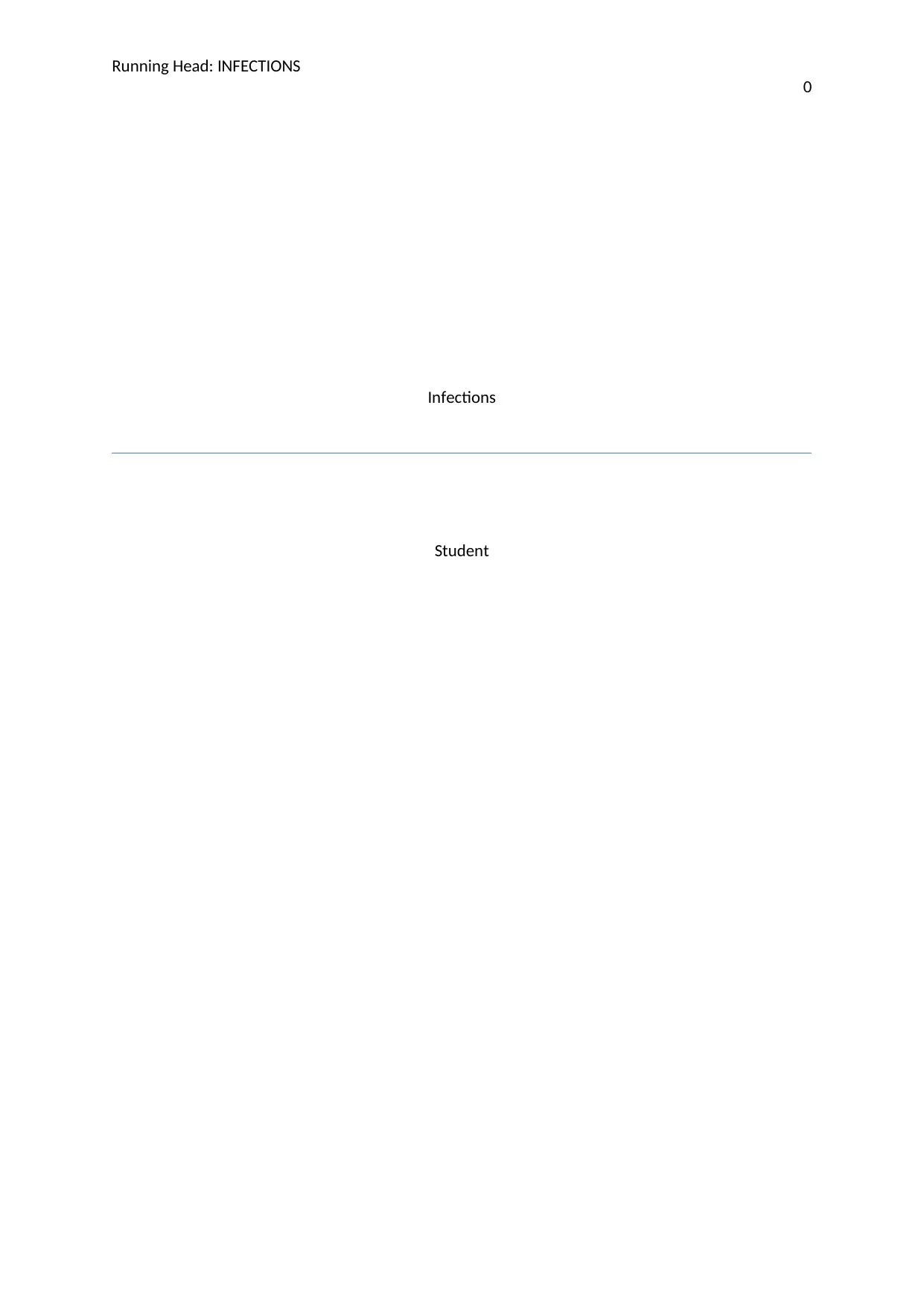
Running Head: INFECTIONS
0
Infections
Student
0
Infections
Student
Secure Best Marks with AI Grader
Need help grading? Try our AI Grader for instant feedback on your assignments.
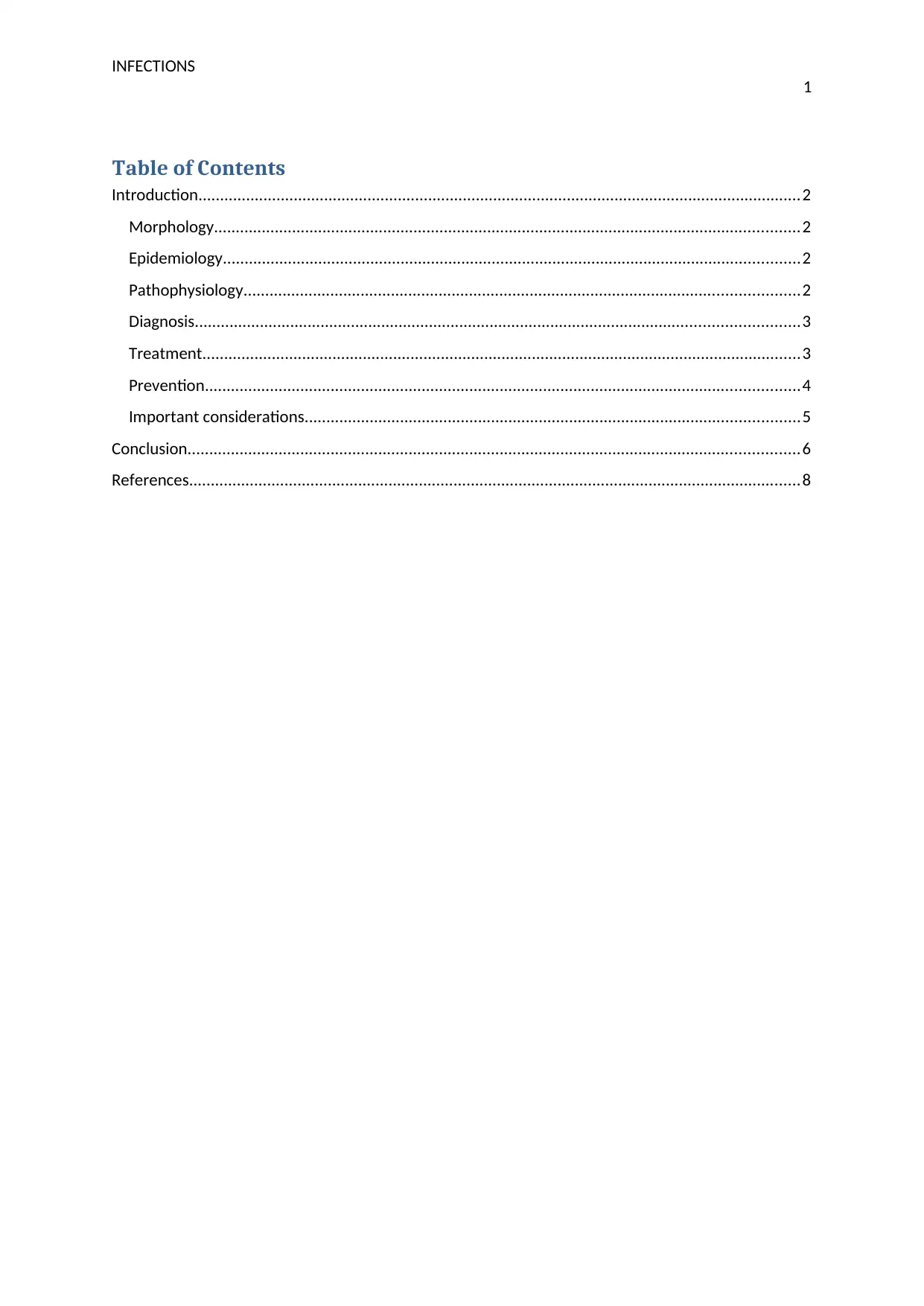
INFECTIONS
1
Table of Contents
Introduction...........................................................................................................................................2
Morphology.......................................................................................................................................2
Epidemiology.....................................................................................................................................2
Pathophysiology................................................................................................................................2
Diagnosis...........................................................................................................................................3
Treatment..........................................................................................................................................3
Prevention.........................................................................................................................................4
Important considerations..................................................................................................................5
Conclusion.............................................................................................................................................6
References.............................................................................................................................................8
1
Table of Contents
Introduction...........................................................................................................................................2
Morphology.......................................................................................................................................2
Epidemiology.....................................................................................................................................2
Pathophysiology................................................................................................................................2
Diagnosis...........................................................................................................................................3
Treatment..........................................................................................................................................3
Prevention.........................................................................................................................................4
Important considerations..................................................................................................................5
Conclusion.............................................................................................................................................6
References.............................................................................................................................................8
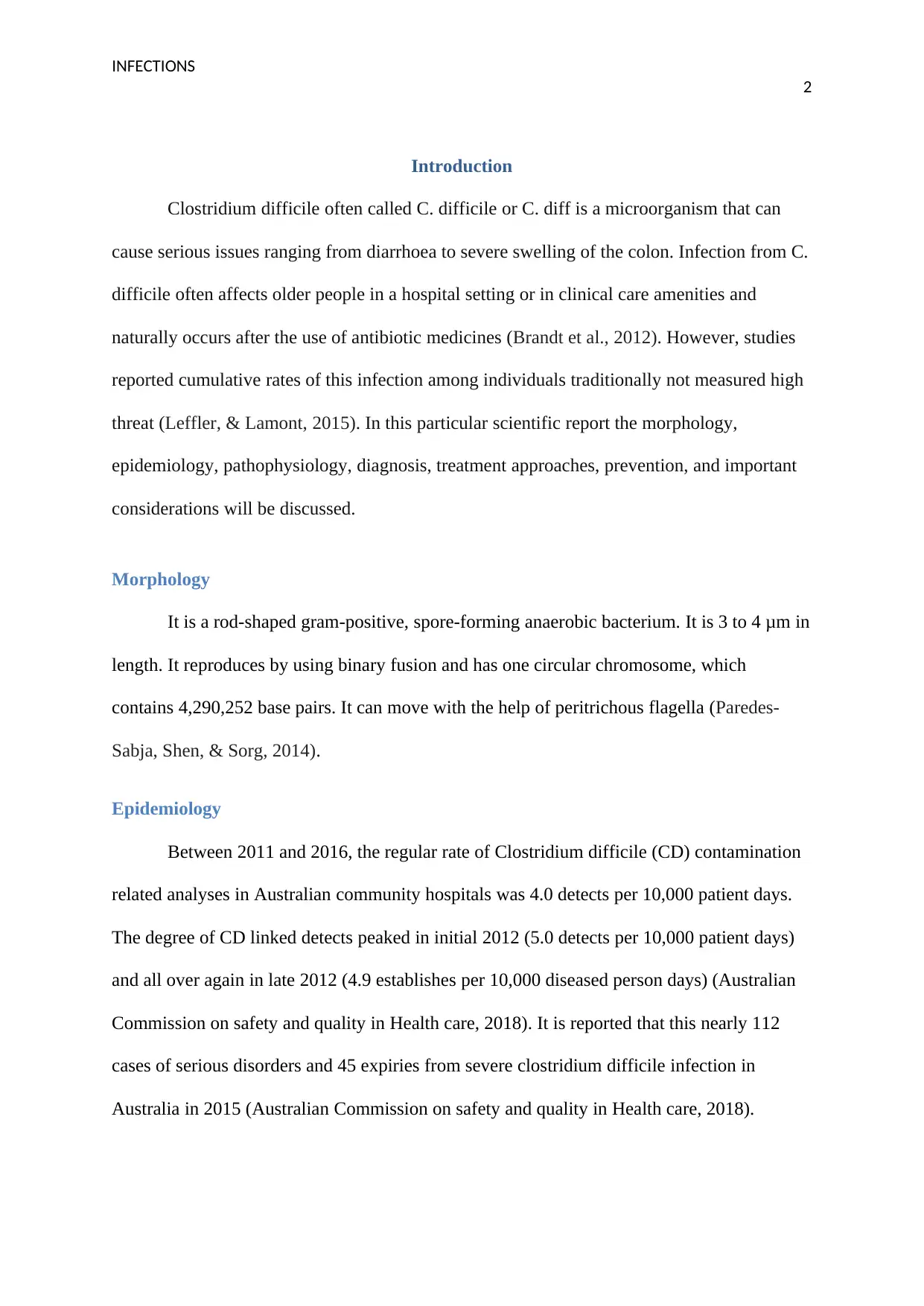
INFECTIONS
2
Introduction
Clostridium difficile often called C. difficile or C. diff is a microorganism that can
cause serious issues ranging from diarrhoea to severe swelling of the colon. Infection from C.
difficile often affects older people in a hospital setting or in clinical care amenities and
naturally occurs after the use of antibiotic medicines (Brandt et al., 2012). However, studies
reported cumulative rates of this infection among individuals traditionally not measured high
threat (Leffler, & Lamont, 2015). In this particular scientific report the morphology,
epidemiology, pathophysiology, diagnosis, treatment approaches, prevention, and important
considerations will be discussed.
Morphology
It is a rod-shaped gram-positive, spore-forming anaerobic bacterium. It is 3 to 4 μm in
length. It reproduces by using binary fusion and has one circular chromosome, which
contains 4,290,252 base pairs. It can move with the help of peritrichous flagella (Paredes-
Sabja, Shen, & Sorg, 2014).
Epidemiology
Between 2011 and 2016, the regular rate of Clostridium difficile (CD) contamination
related analyses in Australian community hospitals was 4.0 detects per 10,000 patient days.
The degree of CD linked detects peaked in initial 2012 (5.0 detects per 10,000 patient days)
and all over again in late 2012 (4.9 establishes per 10,000 diseased person days) (Australian
Commission on safety and quality in Health care, 2018). It is reported that this nearly 112
cases of serious disorders and 45 expiries from severe clostridium difficile infection in
Australia in 2015 (Australian Commission on safety and quality in Health care, 2018).
2
Introduction
Clostridium difficile often called C. difficile or C. diff is a microorganism that can
cause serious issues ranging from diarrhoea to severe swelling of the colon. Infection from C.
difficile often affects older people in a hospital setting or in clinical care amenities and
naturally occurs after the use of antibiotic medicines (Brandt et al., 2012). However, studies
reported cumulative rates of this infection among individuals traditionally not measured high
threat (Leffler, & Lamont, 2015). In this particular scientific report the morphology,
epidemiology, pathophysiology, diagnosis, treatment approaches, prevention, and important
considerations will be discussed.
Morphology
It is a rod-shaped gram-positive, spore-forming anaerobic bacterium. It is 3 to 4 μm in
length. It reproduces by using binary fusion and has one circular chromosome, which
contains 4,290,252 base pairs. It can move with the help of peritrichous flagella (Paredes-
Sabja, Shen, & Sorg, 2014).
Epidemiology
Between 2011 and 2016, the regular rate of Clostridium difficile (CD) contamination
related analyses in Australian community hospitals was 4.0 detects per 10,000 patient days.
The degree of CD linked detects peaked in initial 2012 (5.0 detects per 10,000 patient days)
and all over again in late 2012 (4.9 establishes per 10,000 diseased person days) (Australian
Commission on safety and quality in Health care, 2018). It is reported that this nearly 112
cases of serious disorders and 45 expiries from severe clostridium difficile infection in
Australia in 2015 (Australian Commission on safety and quality in Health care, 2018).
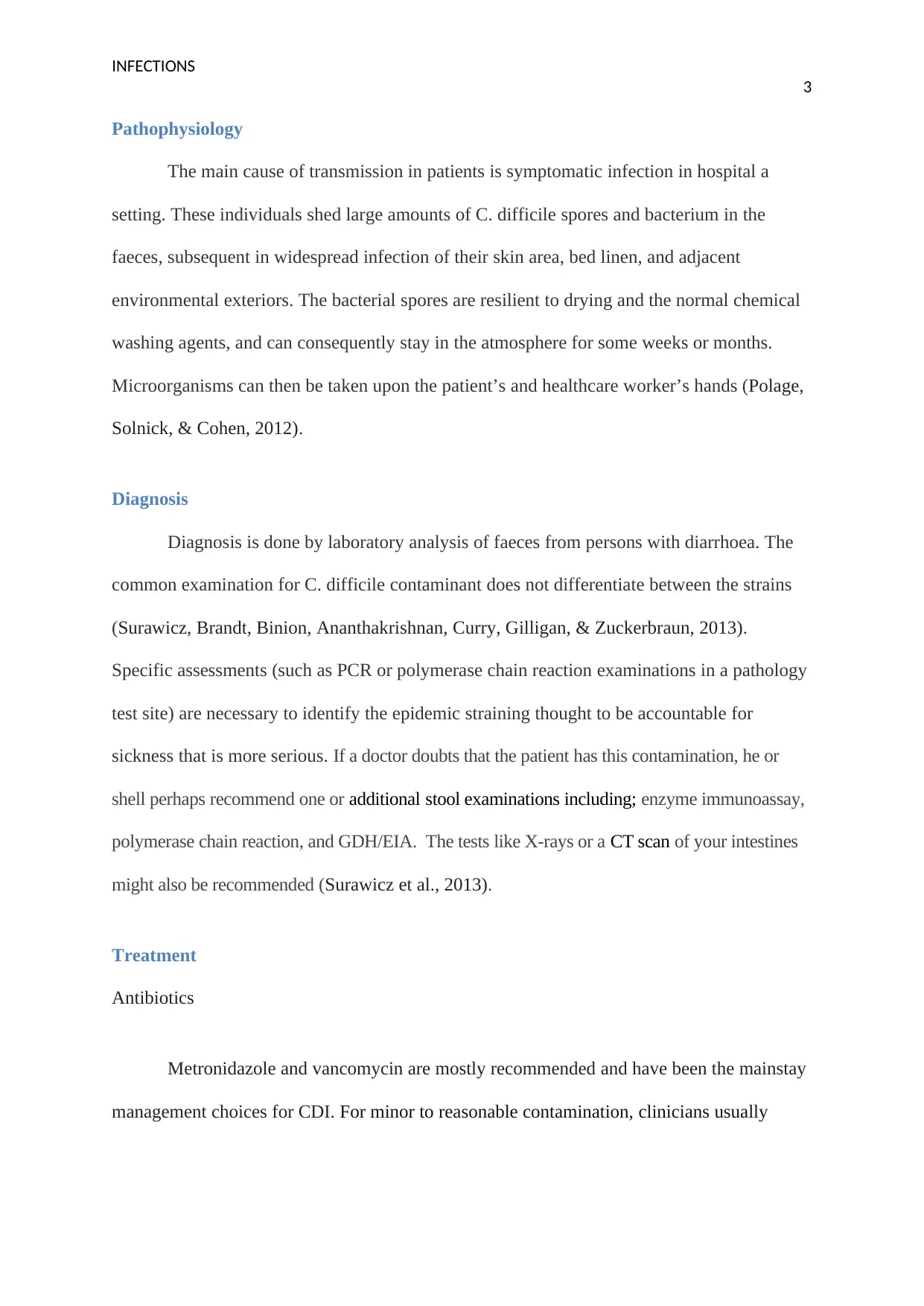
INFECTIONS
3
Pathophysiology
The main cause of transmission in patients is symptomatic infection in hospital a
setting. These individuals shed large amounts of C. difficile spores and bacterium in the
faeces, subsequent in widespread infection of their skin area, bed linen, and adjacent
environmental exteriors. The bacterial spores are resilient to drying and the normal chemical
washing agents, and can consequently stay in the atmosphere for some weeks or months.
Microorganisms can then be taken upon the patient’s and healthcare worker’s hands (Polage,
Solnick, & Cohen, 2012).
Diagnosis
Diagnosis is done by laboratory analysis of faeces from persons with diarrhoea. The
common examination for C. difficile contaminant does not differentiate between the strains
(Surawicz, Brandt, Binion, Ananthakrishnan, Curry, Gilligan, & Zuckerbraun, 2013).
Specific assessments (such as PCR or polymerase chain reaction examinations in a pathology
test site) are necessary to identify the epidemic straining thought to be accountable for
sickness that is more serious. If a doctor doubts that the patient has this contamination, he or
shell perhaps recommend one or additional stool examinations including; enzyme immunoassay,
polymerase chain reaction, and GDH/EIA. The tests like X-rays or a CT scan of your intestines
might also be recommended (Surawicz et al., 2013).
Treatment
Antibiotics
Metronidazole and vancomycin are mostly recommended and have been the mainstay
management choices for CDI. For minor to reasonable contamination, clinicians usually
3
Pathophysiology
The main cause of transmission in patients is symptomatic infection in hospital a
setting. These individuals shed large amounts of C. difficile spores and bacterium in the
faeces, subsequent in widespread infection of their skin area, bed linen, and adjacent
environmental exteriors. The bacterial spores are resilient to drying and the normal chemical
washing agents, and can consequently stay in the atmosphere for some weeks or months.
Microorganisms can then be taken upon the patient’s and healthcare worker’s hands (Polage,
Solnick, & Cohen, 2012).
Diagnosis
Diagnosis is done by laboratory analysis of faeces from persons with diarrhoea. The
common examination for C. difficile contaminant does not differentiate between the strains
(Surawicz, Brandt, Binion, Ananthakrishnan, Curry, Gilligan, & Zuckerbraun, 2013).
Specific assessments (such as PCR or polymerase chain reaction examinations in a pathology
test site) are necessary to identify the epidemic straining thought to be accountable for
sickness that is more serious. If a doctor doubts that the patient has this contamination, he or
shell perhaps recommend one or additional stool examinations including; enzyme immunoassay,
polymerase chain reaction, and GDH/EIA. The tests like X-rays or a CT scan of your intestines
might also be recommended (Surawicz et al., 2013).
Treatment
Antibiotics
Metronidazole and vancomycin are mostly recommended and have been the mainstay
management choices for CDI. For minor to reasonable contamination, clinicians usually
Secure Best Marks with AI Grader
Need help grading? Try our AI Grader for instant feedback on your assignments.
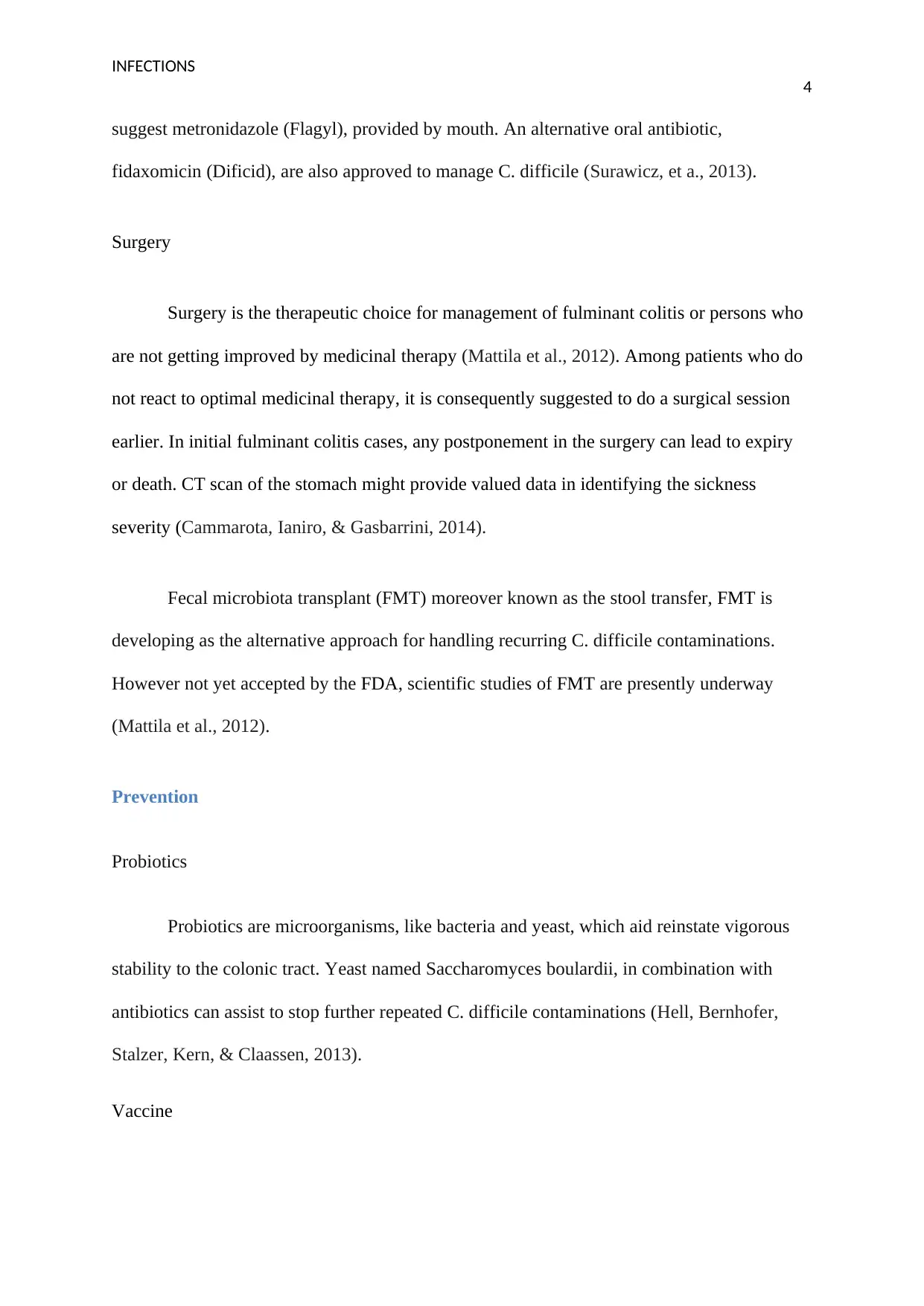
INFECTIONS
4
suggest metronidazole (Flagyl), provided by mouth. An alternative oral antibiotic,
fidaxomicin (Dificid), are also approved to manage C. difficile (Surawicz, et a., 2013).
Surgery
Surgery is the therapeutic choice for management of fulminant colitis or persons who
are not getting improved by medicinal therapy (Mattila et al., 2012). Among patients who do
not react to optimal medicinal therapy, it is consequently suggested to do a surgical session
earlier. In initial fulminant colitis cases, any postponement in the surgery can lead to expiry
or death. CT scan of the stomach might provide valued data in identifying the sickness
severity (Cammarota, Ianiro, & Gasbarrini, 2014).
Fecal microbiota transplant (FMT) moreover known as the stool transfer, FMT is
developing as the alternative approach for handling recurring C. difficile contaminations.
However not yet accepted by the FDA, scientific studies of FMT are presently underway
(Mattila et al., 2012).
Prevention
Probiotics
Probiotics are microorganisms, like bacteria and yeast, which aid reinstate vigorous
stability to the colonic tract. Yeast named Saccharomyces boulardii, in combination with
antibiotics can assist to stop further repeated C. difficile contaminations (Hell, Bernhofer,
Stalzer, Kern, & Claassen, 2013).
Vaccine
4
suggest metronidazole (Flagyl), provided by mouth. An alternative oral antibiotic,
fidaxomicin (Dificid), are also approved to manage C. difficile (Surawicz, et a., 2013).
Surgery
Surgery is the therapeutic choice for management of fulminant colitis or persons who
are not getting improved by medicinal therapy (Mattila et al., 2012). Among patients who do
not react to optimal medicinal therapy, it is consequently suggested to do a surgical session
earlier. In initial fulminant colitis cases, any postponement in the surgery can lead to expiry
or death. CT scan of the stomach might provide valued data in identifying the sickness
severity (Cammarota, Ianiro, & Gasbarrini, 2014).
Fecal microbiota transplant (FMT) moreover known as the stool transfer, FMT is
developing as the alternative approach for handling recurring C. difficile contaminations.
However not yet accepted by the FDA, scientific studies of FMT are presently underway
(Mattila et al., 2012).
Prevention
Probiotics
Probiotics are microorganisms, like bacteria and yeast, which aid reinstate vigorous
stability to the colonic tract. Yeast named Saccharomyces boulardii, in combination with
antibiotics can assist to stop further repeated C. difficile contaminations (Hell, Bernhofer,
Stalzer, Kern, & Claassen, 2013).
Vaccine
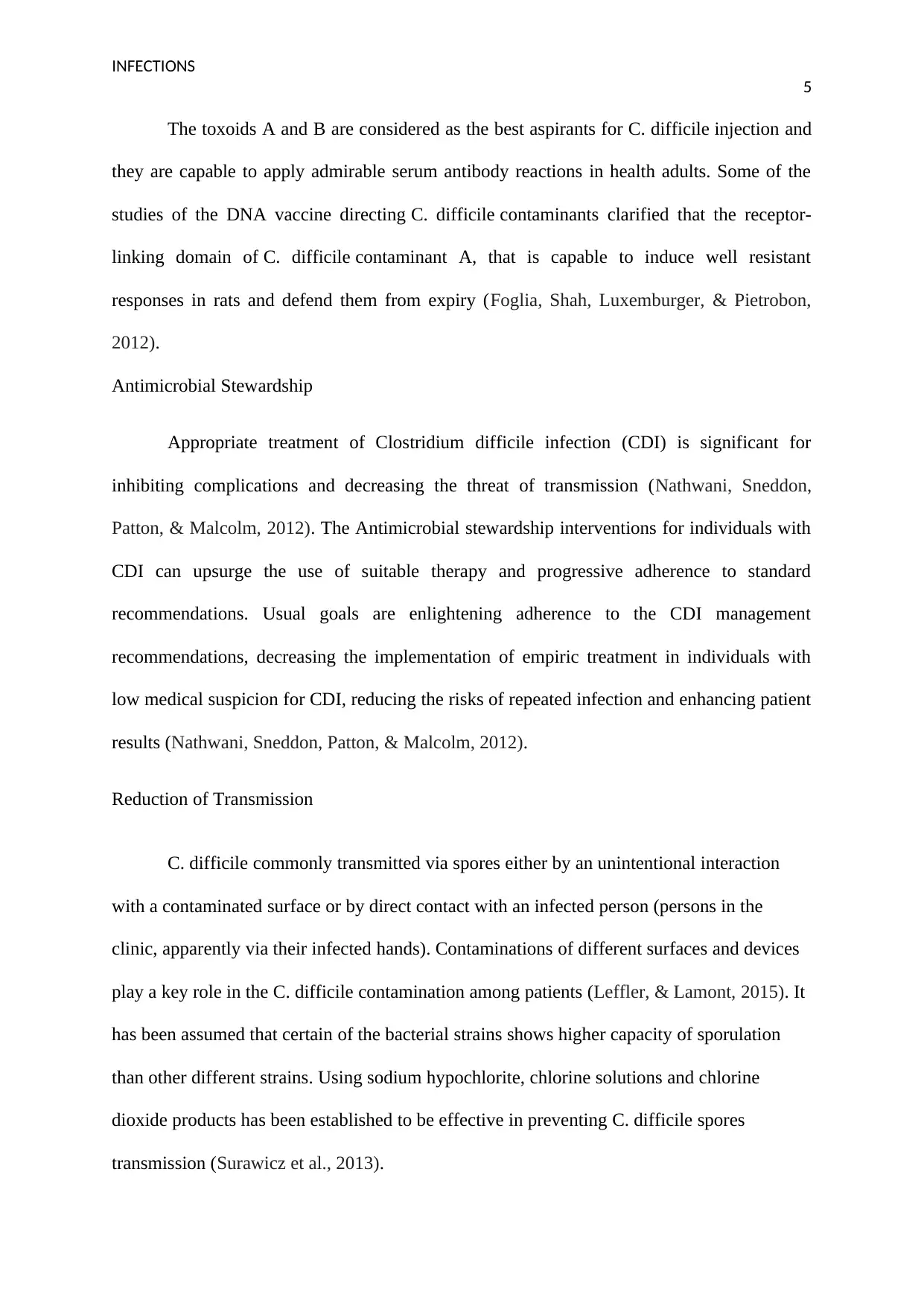
INFECTIONS
5
The toxoids A and B are considered as the best aspirants for C. difficile injection and
they are capable to apply admirable serum antibody reactions in health adults. Some of the
studies of the DNA vaccine directing C. difficile contaminants clarified that the receptor-
linking domain of C. difficile contaminant A, that is capable to induce well resistant
responses in rats and defend them from expiry (Foglia, Shah, Luxemburger, & Pietrobon,
2012).
Antimicrobial Stewardship
Appropriate treatment of Clostridium difficile infection (CDI) is significant for
inhibiting complications and decreasing the threat of transmission (Nathwani, Sneddon,
Patton, & Malcolm, 2012). The Antimicrobial stewardship interventions for individuals with
CDI can upsurge the use of suitable therapy and progressive adherence to standard
recommendations. Usual goals are enlightening adherence to the CDI management
recommendations, decreasing the implementation of empiric treatment in individuals with
low medical suspicion for CDI, reducing the risks of repeated infection and enhancing patient
results (Nathwani, Sneddon, Patton, & Malcolm, 2012).
Reduction of Transmission
C. difficile commonly transmitted via spores either by an unintentional interaction
with a contaminated surface or by direct contact with an infected person (persons in the
clinic, apparently via their infected hands). Contaminations of different surfaces and devices
play a key role in the C. difficile contamination among patients (Leffler, & Lamont, 2015). It
has been assumed that certain of the bacterial strains shows higher capacity of sporulation
than other different strains. Using sodium hypochlorite, chlorine solutions and chlorine
dioxide products has been established to be effective in preventing C. difficile spores
transmission (Surawicz et al., 2013).
5
The toxoids A and B are considered as the best aspirants for C. difficile injection and
they are capable to apply admirable serum antibody reactions in health adults. Some of the
studies of the DNA vaccine directing C. difficile contaminants clarified that the receptor-
linking domain of C. difficile contaminant A, that is capable to induce well resistant
responses in rats and defend them from expiry (Foglia, Shah, Luxemburger, & Pietrobon,
2012).
Antimicrobial Stewardship
Appropriate treatment of Clostridium difficile infection (CDI) is significant for
inhibiting complications and decreasing the threat of transmission (Nathwani, Sneddon,
Patton, & Malcolm, 2012). The Antimicrobial stewardship interventions for individuals with
CDI can upsurge the use of suitable therapy and progressive adherence to standard
recommendations. Usual goals are enlightening adherence to the CDI management
recommendations, decreasing the implementation of empiric treatment in individuals with
low medical suspicion for CDI, reducing the risks of repeated infection and enhancing patient
results (Nathwani, Sneddon, Patton, & Malcolm, 2012).
Reduction of Transmission
C. difficile commonly transmitted via spores either by an unintentional interaction
with a contaminated surface or by direct contact with an infected person (persons in the
clinic, apparently via their infected hands). Contaminations of different surfaces and devices
play a key role in the C. difficile contamination among patients (Leffler, & Lamont, 2015). It
has been assumed that certain of the bacterial strains shows higher capacity of sporulation
than other different strains. Using sodium hypochlorite, chlorine solutions and chlorine
dioxide products has been established to be effective in preventing C. difficile spores
transmission (Surawicz et al., 2013).
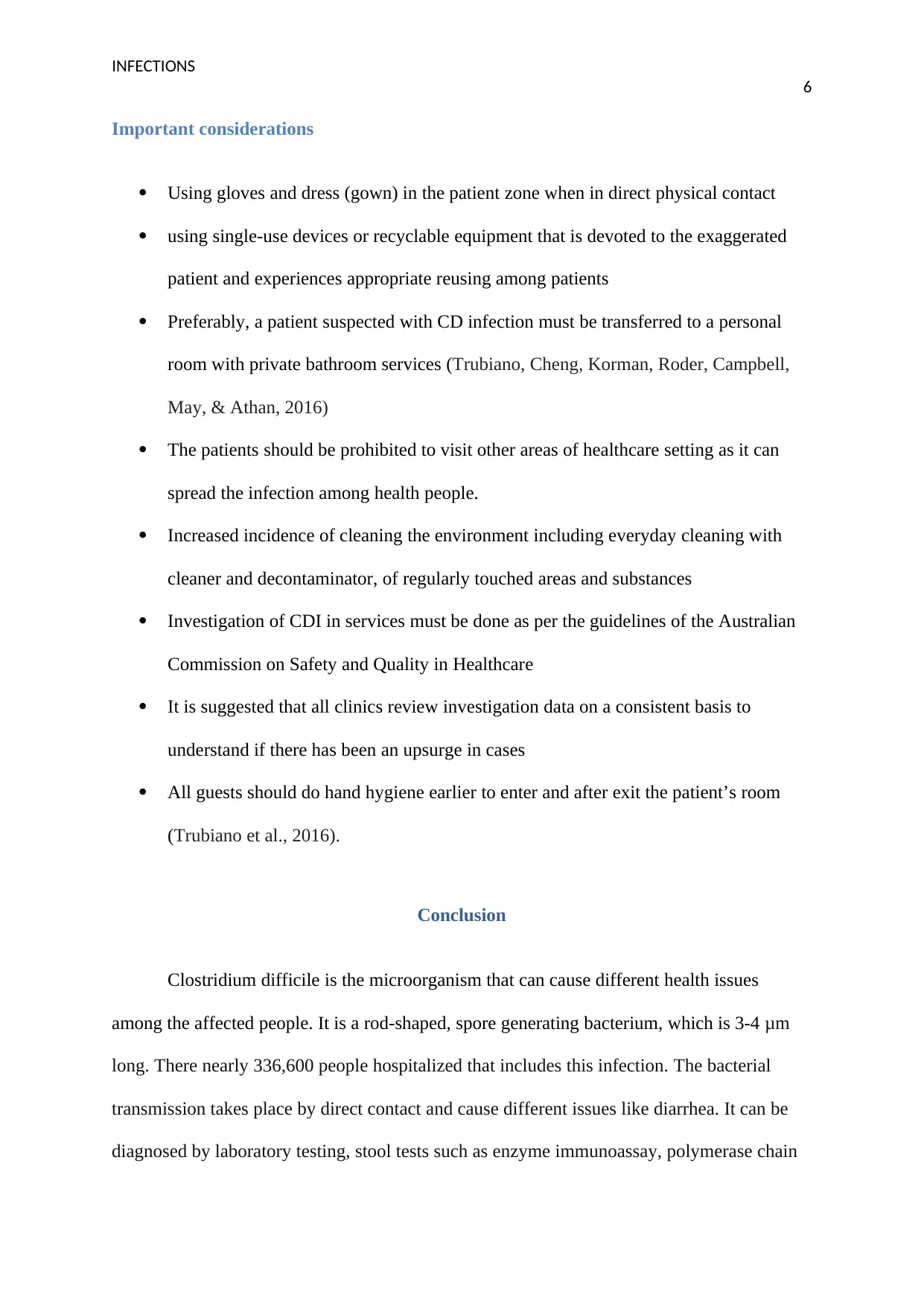
INFECTIONS
6
Important considerations
Using gloves and dress (gown) in the patient zone when in direct physical contact
using single-use devices or recyclable equipment that is devoted to the exaggerated
patient and experiences appropriate reusing among patients
Preferably, a patient suspected with CD infection must be transferred to a personal
room with private bathroom services (Trubiano, Cheng, Korman, Roder, Campbell,
May, & Athan, 2016)
The patients should be prohibited to visit other areas of healthcare setting as it can
spread the infection among health people.
Increased incidence of cleaning the environment including everyday cleaning with
cleaner and decontaminator, of regularly touched areas and substances
Investigation of CDI in services must be done as per the guidelines of the Australian
Commission on Safety and Quality in Healthcare
It is suggested that all clinics review investigation data on a consistent basis to
understand if there has been an upsurge in cases
All guests should do hand hygiene earlier to enter and after exit the patient’s room
(Trubiano et al., 2016).
Conclusion
Clostridium difficile is the microorganism that can cause different health issues
among the affected people. It is a rod-shaped, spore generating bacterium, which is 3-4 μm
long. There nearly 336,600 people hospitalized that includes this infection. The bacterial
transmission takes place by direct contact and cause different issues like diarrhea. It can be
diagnosed by laboratory testing, stool tests such as enzyme immunoassay, polymerase chain
6
Important considerations
Using gloves and dress (gown) in the patient zone when in direct physical contact
using single-use devices or recyclable equipment that is devoted to the exaggerated
patient and experiences appropriate reusing among patients
Preferably, a patient suspected with CD infection must be transferred to a personal
room with private bathroom services (Trubiano, Cheng, Korman, Roder, Campbell,
May, & Athan, 2016)
The patients should be prohibited to visit other areas of healthcare setting as it can
spread the infection among health people.
Increased incidence of cleaning the environment including everyday cleaning with
cleaner and decontaminator, of regularly touched areas and substances
Investigation of CDI in services must be done as per the guidelines of the Australian
Commission on Safety and Quality in Healthcare
It is suggested that all clinics review investigation data on a consistent basis to
understand if there has been an upsurge in cases
All guests should do hand hygiene earlier to enter and after exit the patient’s room
(Trubiano et al., 2016).
Conclusion
Clostridium difficile is the microorganism that can cause different health issues
among the affected people. It is a rod-shaped, spore generating bacterium, which is 3-4 μm
long. There nearly 336,600 people hospitalized that includes this infection. The bacterial
transmission takes place by direct contact and cause different issues like diarrhea. It can be
diagnosed by laboratory testing, stool tests such as enzyme immunoassay, polymerase chain
Paraphrase This Document
Need a fresh take? Get an instant paraphrase of this document with our AI Paraphraser
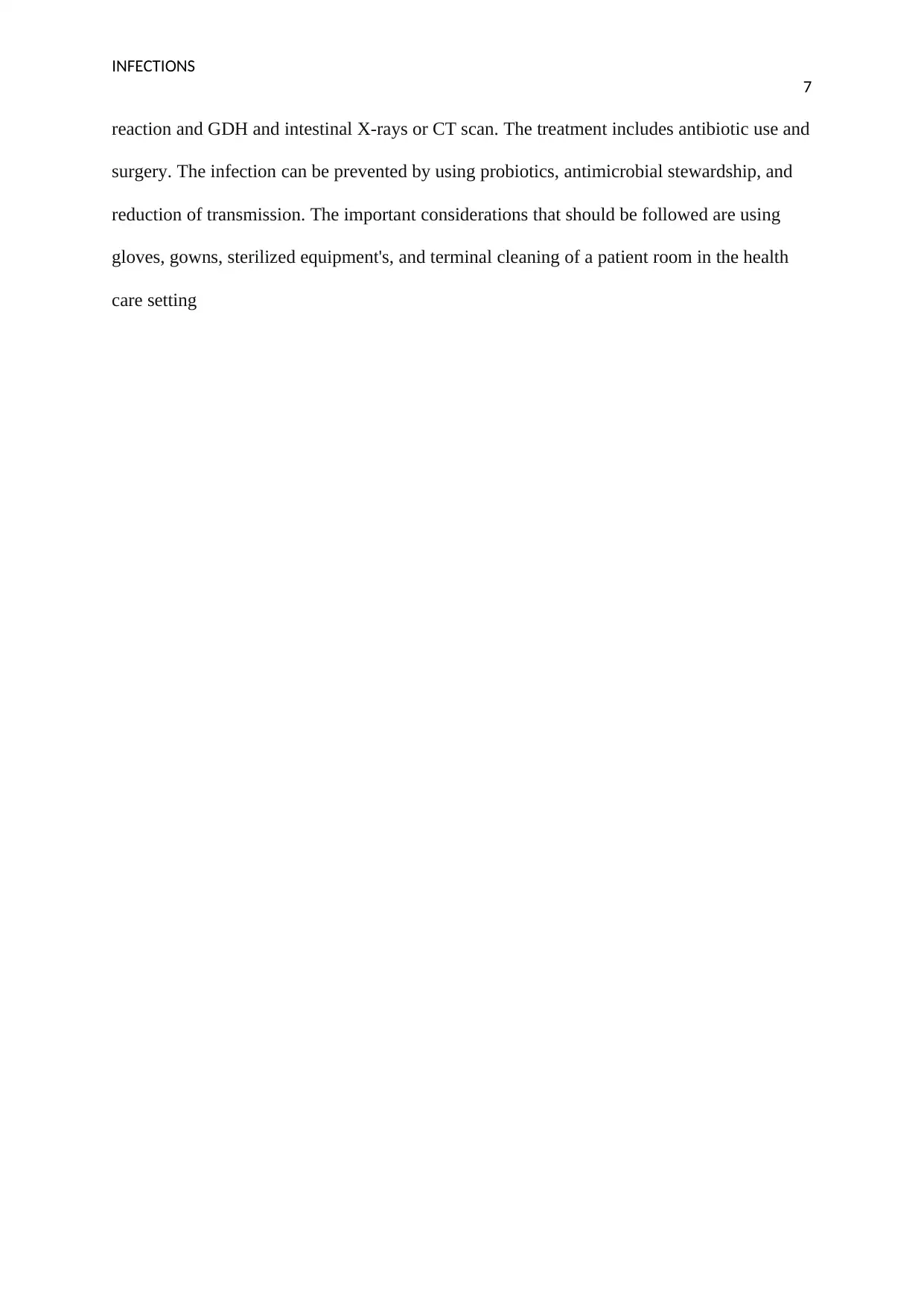
INFECTIONS
7
reaction and GDH and intestinal X-rays or CT scan. The treatment includes antibiotic use and
surgery. The infection can be prevented by using probiotics, antimicrobial stewardship, and
reduction of transmission. The important considerations that should be followed are using
gloves, gowns, sterilized equipment's, and terminal cleaning of a patient room in the health
care setting
7
reaction and GDH and intestinal X-rays or CT scan. The treatment includes antibiotic use and
surgery. The infection can be prevented by using probiotics, antimicrobial stewardship, and
reduction of transmission. The important considerations that should be followed are using
gloves, gowns, sterilized equipment's, and terminal cleaning of a patient room in the health
care setting
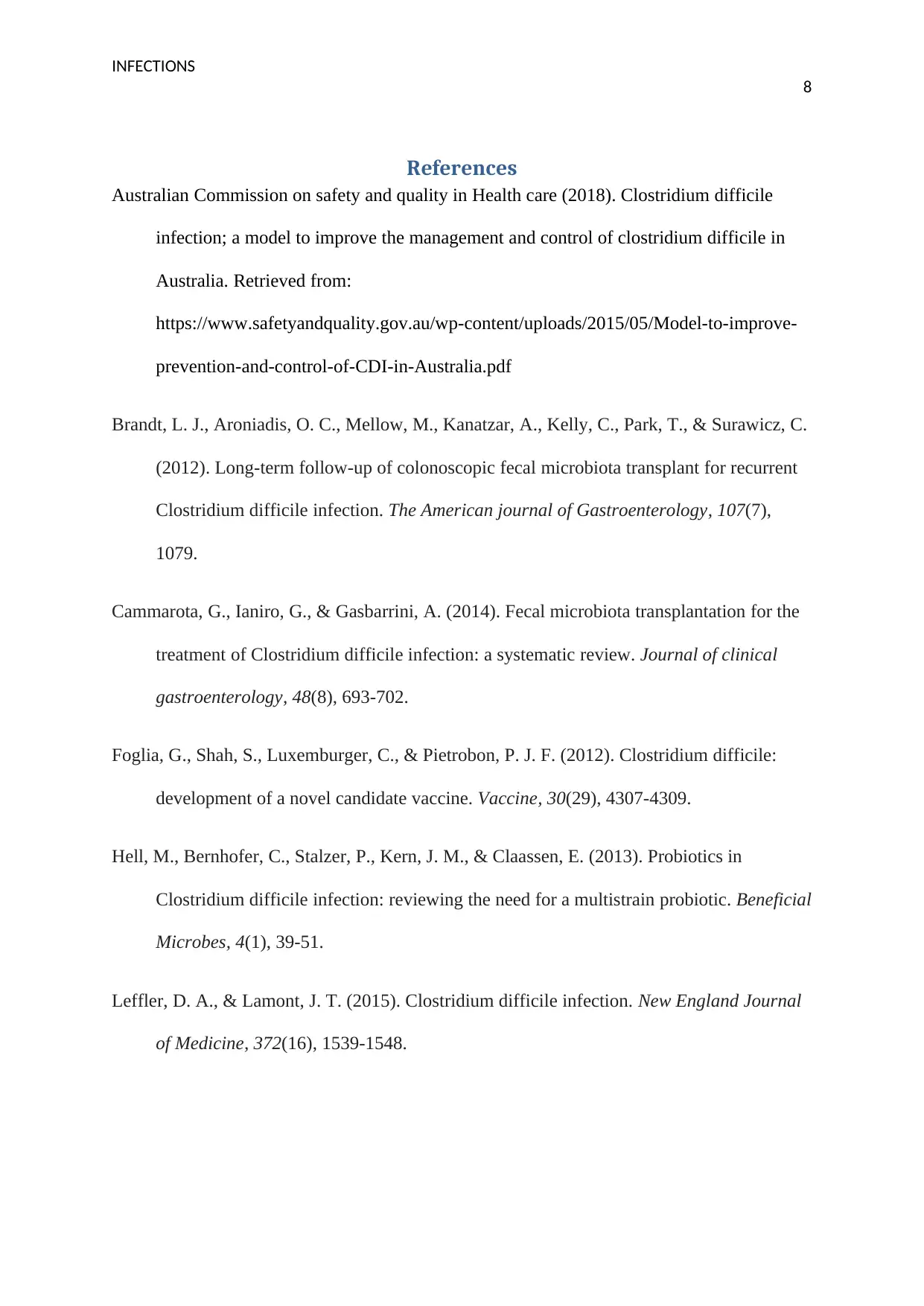
INFECTIONS
8
References
Australian Commission on safety and quality in Health care (2018). Clostridium difficile
infection; a model to improve the management and control of clostridium difficile in
Australia. Retrieved from:
https://www.safetyandquality.gov.au/wp-content/uploads/2015/05/Model-to-improve-
prevention-and-control-of-CDI-in-Australia.pdf
Brandt, L. J., Aroniadis, O. C., Mellow, M., Kanatzar, A., Kelly, C., Park, T., & Surawicz, C.
(2012). Long-term follow-up of colonoscopic fecal microbiota transplant for recurrent
Clostridium difficile infection. The American journal of Gastroenterology, 107(7),
1079.
Cammarota, G., Ianiro, G., & Gasbarrini, A. (2014). Fecal microbiota transplantation for the
treatment of Clostridium difficile infection: a systematic review. Journal of clinical
gastroenterology, 48(8), 693-702.
Foglia, G., Shah, S., Luxemburger, C., & Pietrobon, P. J. F. (2012). Clostridium difficile:
development of a novel candidate vaccine. Vaccine, 30(29), 4307-4309.
Hell, M., Bernhofer, C., Stalzer, P., Kern, J. M., & Claassen, E. (2013). Probiotics in
Clostridium difficile infection: reviewing the need for a multistrain probiotic. Beneficial
Microbes, 4(1), 39-51.
Leffler, D. A., & Lamont, J. T. (2015). Clostridium difficile infection. New England Journal
of Medicine, 372(16), 1539-1548.
8
References
Australian Commission on safety and quality in Health care (2018). Clostridium difficile
infection; a model to improve the management and control of clostridium difficile in
Australia. Retrieved from:
https://www.safetyandquality.gov.au/wp-content/uploads/2015/05/Model-to-improve-
prevention-and-control-of-CDI-in-Australia.pdf
Brandt, L. J., Aroniadis, O. C., Mellow, M., Kanatzar, A., Kelly, C., Park, T., & Surawicz, C.
(2012). Long-term follow-up of colonoscopic fecal microbiota transplant for recurrent
Clostridium difficile infection. The American journal of Gastroenterology, 107(7),
1079.
Cammarota, G., Ianiro, G., & Gasbarrini, A. (2014). Fecal microbiota transplantation for the
treatment of Clostridium difficile infection: a systematic review. Journal of clinical
gastroenterology, 48(8), 693-702.
Foglia, G., Shah, S., Luxemburger, C., & Pietrobon, P. J. F. (2012). Clostridium difficile:
development of a novel candidate vaccine. Vaccine, 30(29), 4307-4309.
Hell, M., Bernhofer, C., Stalzer, P., Kern, J. M., & Claassen, E. (2013). Probiotics in
Clostridium difficile infection: reviewing the need for a multistrain probiotic. Beneficial
Microbes, 4(1), 39-51.
Leffler, D. A., & Lamont, J. T. (2015). Clostridium difficile infection. New England Journal
of Medicine, 372(16), 1539-1548.
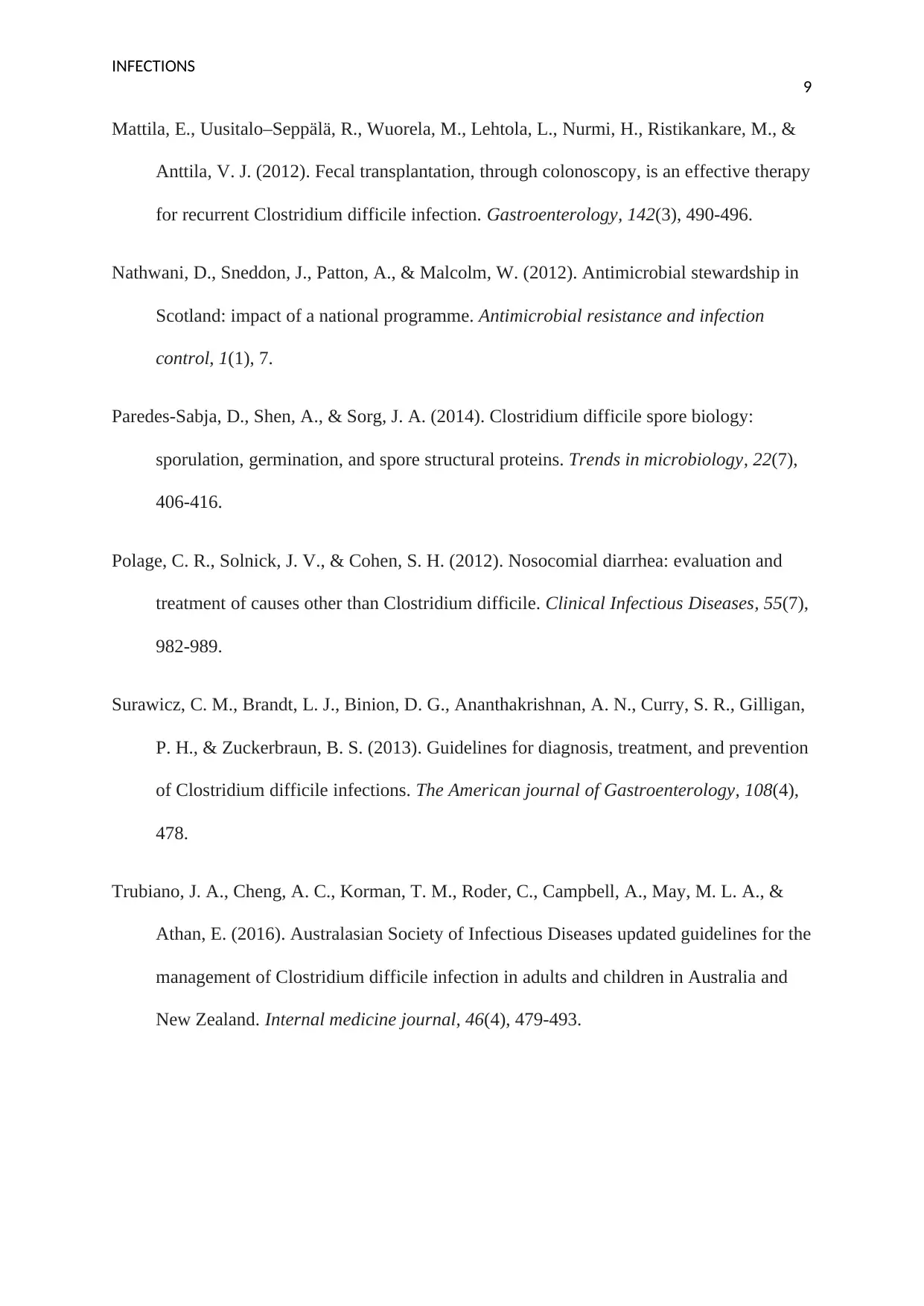
INFECTIONS
9
Mattila, E., Uusitalo–Seppälä, R., Wuorela, M., Lehtola, L., Nurmi, H., Ristikankare, M., &
Anttila, V. J. (2012). Fecal transplantation, through colonoscopy, is an effective therapy
for recurrent Clostridium difficile infection. Gastroenterology, 142(3), 490-496.
Nathwani, D., Sneddon, J., Patton, A., & Malcolm, W. (2012). Antimicrobial stewardship in
Scotland: impact of a national programme. Antimicrobial resistance and infection
control, 1(1), 7.
Paredes-Sabja, D., Shen, A., & Sorg, J. A. (2014). Clostridium difficile spore biology:
sporulation, germination, and spore structural proteins. Trends in microbiology, 22(7),
406-416.
Polage, C. R., Solnick, J. V., & Cohen, S. H. (2012). Nosocomial diarrhea: evaluation and
treatment of causes other than Clostridium difficile. Clinical Infectious Diseases, 55(7),
982-989.
Surawicz, C. M., Brandt, L. J., Binion, D. G., Ananthakrishnan, A. N., Curry, S. R., Gilligan,
P. H., & Zuckerbraun, B. S. (2013). Guidelines for diagnosis, treatment, and prevention
of Clostridium difficile infections. The American journal of Gastroenterology, 108(4),
478.
Trubiano, J. A., Cheng, A. C., Korman, T. M., Roder, C., Campbell, A., May, M. L. A., &
Athan, E. (2016). Australasian Society of Infectious Diseases updated guidelines for the
management of Clostridium difficile infection in adults and children in Australia and
New Zealand. Internal medicine journal, 46(4), 479-493.
9
Mattila, E., Uusitalo–Seppälä, R., Wuorela, M., Lehtola, L., Nurmi, H., Ristikankare, M., &
Anttila, V. J. (2012). Fecal transplantation, through colonoscopy, is an effective therapy
for recurrent Clostridium difficile infection. Gastroenterology, 142(3), 490-496.
Nathwani, D., Sneddon, J., Patton, A., & Malcolm, W. (2012). Antimicrobial stewardship in
Scotland: impact of a national programme. Antimicrobial resistance and infection
control, 1(1), 7.
Paredes-Sabja, D., Shen, A., & Sorg, J. A. (2014). Clostridium difficile spore biology:
sporulation, germination, and spore structural proteins. Trends in microbiology, 22(7),
406-416.
Polage, C. R., Solnick, J. V., & Cohen, S. H. (2012). Nosocomial diarrhea: evaluation and
treatment of causes other than Clostridium difficile. Clinical Infectious Diseases, 55(7),
982-989.
Surawicz, C. M., Brandt, L. J., Binion, D. G., Ananthakrishnan, A. N., Curry, S. R., Gilligan,
P. H., & Zuckerbraun, B. S. (2013). Guidelines for diagnosis, treatment, and prevention
of Clostridium difficile infections. The American journal of Gastroenterology, 108(4),
478.
Trubiano, J. A., Cheng, A. C., Korman, T. M., Roder, C., Campbell, A., May, M. L. A., &
Athan, E. (2016). Australasian Society of Infectious Diseases updated guidelines for the
management of Clostridium difficile infection in adults and children in Australia and
New Zealand. Internal medicine journal, 46(4), 479-493.
1 out of 10
Your All-in-One AI-Powered Toolkit for Academic Success.
+13062052269
info@desklib.com
Available 24*7 on WhatsApp / Email
![[object Object]](/_next/static/media/star-bottom.7253800d.svg)
Unlock your academic potential
© 2024 | Zucol Services PVT LTD | All rights reserved.